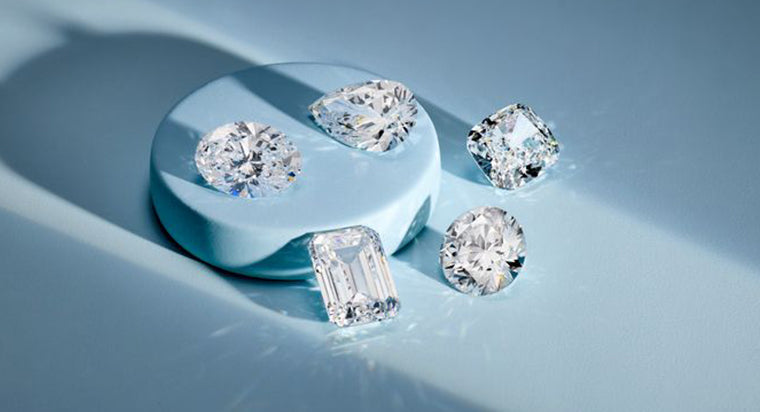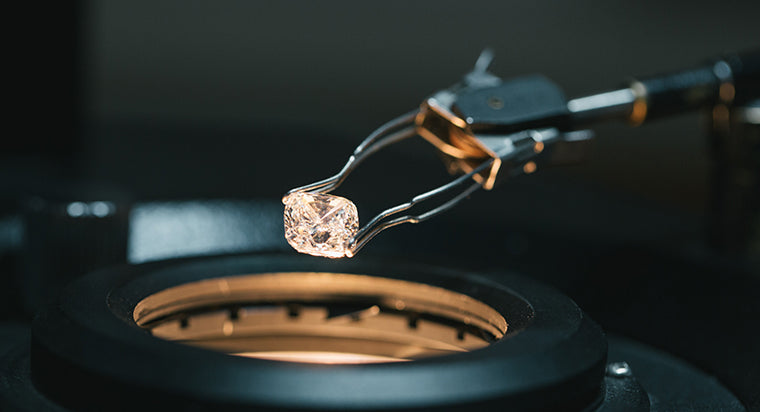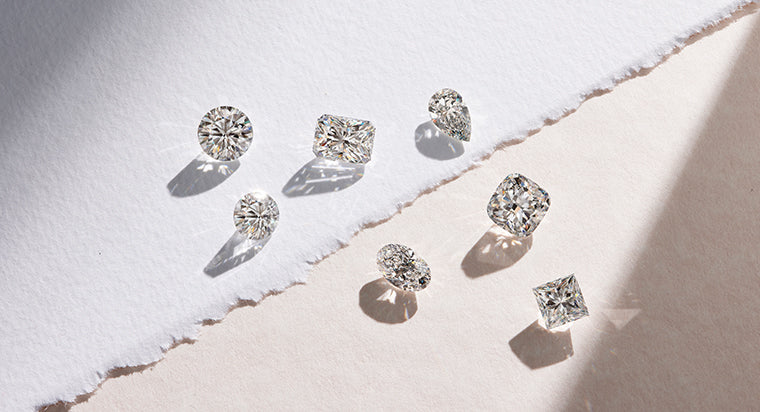Diamond Shape

A diamond's shape is its most distinguishing and easily identifiable feature. Diamonds are cut in a variety of shapes that maximize diamond brilliance and give character to the diamond. Different shapes can represent different personalities and events. Round brilliant cuts are the most popular, followed by Princess cut diamonds. At With Clarity, we offer the 9 most popular diamond shapes, certified by GIA. Learn more about each shape below.
TABLE OF CONTENTS
About Diamond Shapes
Diamonds are cut in a variety of shapes. But how does a diamond cutter decide what shape to create? Well, a diamond cutters number one responsibility is to preserve and maximize carat weight. And since rough diamond can come in unpredictable shapes and sizes, the diamond cutter will create whichever shape maximizes carat weight and value.
Interestingly enough, round cut diamonds actually result in the most wastage of rough diamond carat. The other fancy shapes are deeper and tend to have longer, less uniform shaping so they capture more of the rough diamond.
While diamonds can be cut in any shape, there are 10 popular diamond shapes: Round, Princess, Cushion, Oval, Emerald, Pear, Marquise, Asscher, Radiant and Heart shape. Exotic shapes include Baguettes, Bullets, Half Moons, Trillion, Old Mine, Rose, even Horse head. While new diamond shapes are being invented, there are a classic few that have stood the test of time. They have endured for their beauty, and ability to showcase the sparkle of the diamond.

Diamond shape popularity has always been popular as jewelers have always been looking for a way to maximize the amount of shine of a single ring. Jewelers had their own agenda for creating shinier rings- the shinier the ring, the more they could charge. However, what started as a method to earn more money per ring turned into a very popular concept. Diamond shapes are incredibly popular today, and most people would consider the shape of diamond to be one of the most important factors of any ring.
This popularity stems from the difference in price, the lifespan of the diamond, and the appearance of the ring. With this being said, it is clear that different diamond shapes are more prone to damage than others, and therefore, it is important for the woman to do her research to determine what diamond shape will work the best for her lifestyle. Additionally, different diamond shapes have different essences. Some are considerably more modern while others seem more classic. These vibes are incredibly important to look out for when choosing a diamond because the shape could change the entire feeling of the ring as a whole. When choosing a shape for an engagement ring, be sure to pick something that resonates with your likes and personality, since you will be wearing it for a long time. Something classic and versatile will also blend in easily with any other jewelry and clothing that you wear. Don't make a decision simply based on what is trending.
Shapes
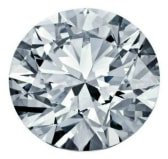
Round: STYLE: classic, elegant, sparkling
Most popular and researched shape - When cut well, the proper reflection of light, the potential of brilliance and brightness is maximized. The round brilliant cut diamond has 58 facets. Its 58-facet cut, divided among its crown (top), girdle (widest part) and pavilion (base), is calibrated through a precise formula to achieve the maximum in fire and brilliance. When cutting a rough stone, more is lost in shaping a round diamond, so the cost of each carat retained is higher. Over 75% of the world's diamonds are Round Brilliants.
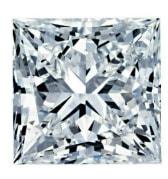
Princess: STYLE: trendy, beautiful, angelic
Second most popular shape - prefered in square shape but available in rectangular shape also. The princess cuts that are slightly rectangular tend to be lower in cost. This cut requires more weight to be directed toward the diamond's depth in order to maximize brilliance. Depth percentages of 70% to 78% are common. Ideal square ratio ranges from 1.00 to 1.05. A princess cut should always be set for 4 prongs protecting its corners from chips. It is ideal for long fingers and wedding bands. It has 57 or 58 facets and is known as square modified brilliant cut or Rectangular Modified Brilliant when the ration is greater than 1.10
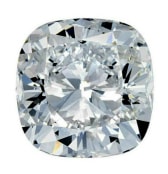
Cushion: STYLE: romantic, graceful, sophisticated
Cushion cuts blend the energy of a round brilliant with the symmetry of a radiant cut. It's romantic appeal is reflected in its larger 58 facets and rounded, squared corners. Also known as the "pillow cut," the cushion cut has larger faceting, which augments the diamond's brilliance. Larger facets can show clarity inclusions, so evaluate the location of inclusions by examining the certificate's diamond plot. Cushion cuts are popular in both square and rectangular shapes. Square cuts are generally a bit rarer, but do look more symmetrical in an engagement ring. Cushion cut diamonds have great fire (the light that is reflected out of a diamond in a rainbow of color).
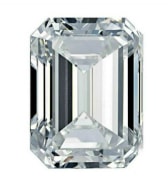
Emerald: STYLE: modern, bold, glamorous
Emerald cuts represent unification, as they are well proportioned and bring out the pure brilliance of a diamond. Also known as "step cut" because of the layered faceting, the emerald cut possesses unique appeal with symmetrical sparkle. The faceting is minimal and simple, and therefore tends to show inclusions. The diamond has 58 facets, roughly 25 on the crown, 25 on the pavilion, and 8 on the girdle with 3 rows of bottom steps and three rows of top steps. An open setting can also show the diamond's color, so closed or bezel type settings are recommended with lower colors.
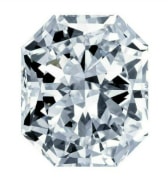
Radiant: STYLE: fiery, diva, provocative
A beautifully symmetrical, non-traditional cut, the radiant cut combines the brilliance of a round and the purity of an emerald cut. Trimmed corners give it versatility among all kinds of jewelry, especially engagement rings. The faceting of a radiant cut gives it a fiery look compared to a princess cut, while maintaining soft, cut corners. The radiant fuses the plus points of other popular diamond shapes. The rectangular radiant cut is an excellent option for buyers who like the emerald cut shape, but want something with the brilliance of a round. A ratio of 1.00 to 1.05 will create a square shape, and from 1.30 to 1.50 will produce a rectangle.
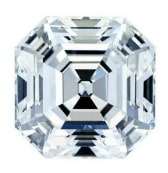
Asscher: STYLE: balanced, vintage, creative
The asscher cut is (also a step cut diamond like the emerald cut) is a blend of the princess and emerald cuts with X-shaped facets from its corners to its center culet. The brilliance of its faceting can mask certain inclusions and lower color grades. Asscher cut diamonds have a clean balance, visual appeal, and can reflect clarity inclusions and color. Higher grades in both categories are generally recommended. The step cut emphasizes the clarity of the diamond, and it is ideal for showcasing higher clarity diamonds. Asscher cuts are a popular shape that was developed during the Art Deco Period. Suggested Cut Ratio: 1.00 to 1.05 for square proportions.
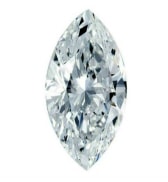
Marquise: STYLE: dramatic, moving, joyful
The marquise cut is a classic and historic diamond that resembles the delight of a smile. The marquise is a variant of round and pear shaped diamonds, and like the oval is a perfect complement to long, slender fingers. The marquise cut's elongated body can make its appearance larger than its actual carat weight. It is an excellent cut to show the impression of long, slender fingers. Suggested Cut Ratio: 1.75 to 2.25 is the ideal shape.
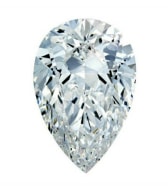
Pear: STYLE: contemporary, unique, gentle
The pear shape diamond is artistic due to its many stylish variations. With 58 facets, light dances through the diamond similar to a round brilliant, maximizing sparkle. It's teardrop appearance leaves a lasting impression. The pear shape’s body allows the wearer the option of pointing it up or down. Its faceting often masks inclusions, and those found near the point tend to be less visible. Pear shapes can be wide or elongated, with longer pear shapes providing a slimming effect on fingers. Suggested cut ratio: 1.5 - 1.7. Most flaws such as naturals, and extra facets are at the point of the diamond. Always set the diamond with a prong covering the point of the stone to prevent any chipping.
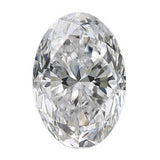
Oval: STYLE: trendy, elegant, delicate
Created in the mid 1900s, the oval cut is simply an elongated round brilliant cut diamond. Oval diamonds have the brilliance of the round, but they grab more attention thanks to their unique shape. This is a fashionable cut because, though you'll need to watch for a couple factors when shopping, they can appear larger than a round diamond at the same caract weight. It's also beloved for its ability to flatter the hand. The shape may have been developed to represent the longevity of a relationship, but it's valued because the oval diamond can make one's fingers look longer and thinner.
The oval diamond's ability to elongate your hands adds elegant to any ring with this style stone. But it's delicate thanks to its rounded edges. They add a gentle touch to the length of this stone, in contrast to the marquise cut's bold points. You need to be careful when selecting your diamond color with this style stone, though. The rounded ends have a tendency to show more color than a round diamond would, so it's wide to go up a color grade to make sure the ends appear colorless.
Lab Grown Diamond Shapes
Just like there are a variety of shapes available in a natural diamond, the same shapes are also available in a lab grown diamond. Lab grown diamonds have the same optical, chemical as well as physical characteristics as mined diamonds. Being 100% real diamonds, the only difference lies in the origin of the diamonds. As the name suggests, lab grown diamonds are grown inside a laboratory and under controlled conditions. The lab diamond rough is created using extreme pressure and heat but inside a machine rather than the layers of the Earth.
Certified by IGI, lab grown diamonds are certified basis the same characteristics as those of the natural ones. Even with lab grown diamonds, it is necessary that the “best” possible shape is chosen for a particular stone. As you know, the gem shape is chosen to hide flaws. Even lab grown diamonds have flaws or inclusions that need to be hidden. Once the stone is studied, the cutter will decide what kind of shape will be best suited. From deciding how to hide (read: cut) the flaws, and maximize fire and brilliance, to getting the most value out of the rough stone, the cutter’s job from taking the rough stone to a finished product is a journey in itself.
With lab diamond shapes, the round brilliant holds first place and is the most popular owing to the fire it offers in comparison to other shapes. Another popular lab grown diamond shape is the oval since it is trendy and looks larger than it really is. Economical and again offering a larger size, a marquise, pear, or cushion cut lab diamond shape makes for an ideal choice. These shapes require less of the original stone to be wasted. For the same reason, an Asscher or emerald cut also offers a great piece with great value.
The lab diamond roughs allow for fancy shapes to be cut with ease. This has to do with the making of the rough diamond in the growing process. Pick a lab diamond shape that best suits you, your taste, and your budget.
FAQs
How are diamonds cut?
It is a well-known fact that diamonds can only be cut with diamonds, so the tools that are used to cut the diamonds are usually diamond bladed or have some amount of diamond dust on them.
After a thorough evaluation of the rough diamond, the cutter determines whether the diamond is to be shaped using a step cut or a brilliant cut. There are five steps involved in the process namely planning, cleaving, bruiting, polishing, and inspecting. Once this is done, gem experts grade the finished product based on the 4 C’s that we all know about.
What is a princess cut diamond?
What is a cushion-cut diamond?
What is the most expensive diamond cut?

